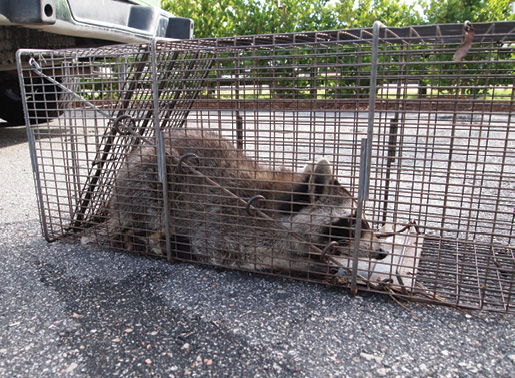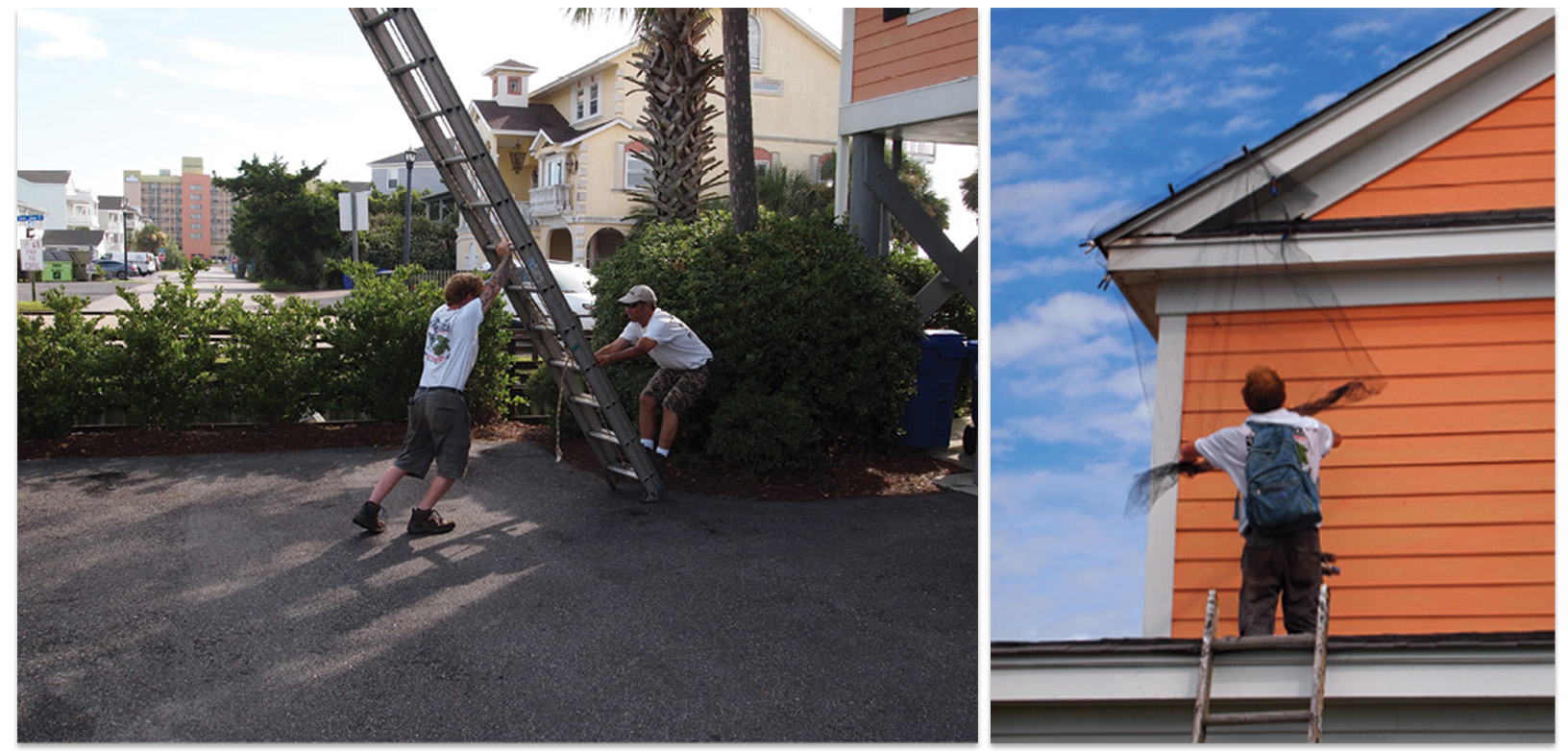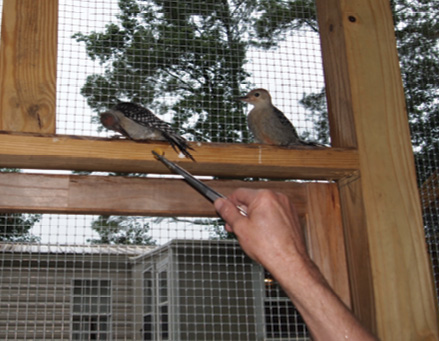A Day in the Life of the Grand Strand’s Snake Chasers

On a recent rainy day in picturesque rural Longs, South Carolina, just past Wampee and only 10 minutes inland from the urban sprawl of the Grand Strand’s U.S. 17 concrete corridor, I met 53-year-old Russell Cavender. The lifelong Horry County resident is known as “Russ” to his friends and “The Snake Chaser” to most everyone else. Cavender’s home sits on a critter-centric compound with 20 acres of land for his horses to graze and run, for the odd emu to peck for insects, and for a half-dozen outbuildings to serve as rehab centers for the many animals that are a part of his extended family, each with their own unique story.
Though no two days are alike for the Snake Chaser crew, on call 24/7, in an effort to understand what the job is like, I was afforded a sneak peek at part of what makes up a typical day: rescuing raccoons from the Ocean Lakes Campground, clearing bats from an oceanfront home in Surfside Beach and catching copperheads at dusk in an affluent Murrells Inlet neighborhood. This, I would come to learn, is fairly typical in the unpredictable business of nuisance wildlife removal.

9:05 a.m.
The hottest days, I’m told, bring a lot of bat calls. These flying mammals (the only mammals capable of sustained flight) are active at night, even in the heat, and are mostly beneficial to humanity. Even though they eat bugs by the bucketful, nobody wants them in their attic.
I meet Snake Chaser James Sargent and Cavender’s son, Hayden Cavender, in an oceanfront neighborhood on the South Strand. The homeowner had made an appointment to clear the bats, and the Snake Chasers were there to accommodate.
“We don’t catch or trap bats,” explains Sargent, who’s been with the company for 14 years. “We find where they’re coming and going, seal up any other possible places they might sneak in and out of, then put up soft plastic nets, with an escape route. The bats fly out at night, hit the net, fall through the holes we’ve created, then they go on their way. They’re unable to figure out how to get back in, so they just move on.”
No harm, no foul. This method is highly effective, humane, and takes just a few days to work. No more bats.

10:15 a.m.
The team of Sargent, who is 45, and Cavender, 30, are just about finished with their own high-flying routine at the oceanfront home, with curious onlookers wondering just what is going on. The men run ridiculously tall (and heavy) ladders up and down the three-story structure with practiced ease. This is not a job for the average homeowner. It takes skill, nerves and athleticism. This first bat job was one of eight on the books for that day alone.
Meanwhile, another Snake Chaser team makes their rounds spraying snake repellent all day every day for commercial and some residential clients who are on contract. In the same way you might hire a termite or pest control company to spray and check baits, the Snake Chasers service hundreds of contracted clients with a snake repellent.
“We use commercial bobcat urine,” says Cavender. “It’s really good at keeping snakes away.” When it doesn’t, the Snake Chasers resort to the old-fashioned methods of hunting them down.
Earlier in the day, another contract client, Ocean Lakes Campground in Myrtle Beach, placed a call when three juvenile raccoons fell through the drop ceiling of the campground’s grocery store. The Snake Chasers were on the job right away and had the three rascals rounded up in Havahart animal-friendly traps. Apparently healthy but shaken up, the young animals are delivered to an individual licensed to rehabilitate. This scenario is true with most nuisance animals, including many that find their way into wildlife removal traps, with one notable, and many say unfair, exception: alligators.
“If a permit is issued to remove a nuisance alligator,” says a Department of Natural Resources staffer, “they’re required to put them down. It’s the law. They are not relocated.”
For this reason, says DNR, they often try to talk people out of insisting that a permit be issued in all but the most serious cases. The best way to save alligators from this fate is to not feed them and to leave them alone. Alligators that are habituated to humans, through no fault of their own, are destined to be put down.
“Killing a threatened species because they cross the road just makes no sense. I refuse to kill them,” says Cavender. “It’s just unnecessary in my opinion. There are many places alligators may be taken so that both they and the public are safe.”
Sargent has a pragmatic understanding of the sometimes-difficult decisions law enforcement occasionally have to make.
“If it’s a true nuisance animal [possum, raccoon, squirrel, etc.], a destructive animal or sick animal, they need to be put down humanely,” he says, “but if it’s a young animal just in the wrong place at the wrong time, we rehabilitate and relocate. We love animals. All animals.”

11:30 a.m.
After a brief lunch, I revisit Snake Chaser headquarters in Longs and get the lay of the land.
“This is Ray,” says Cavender, when an energetic crow hops off the seat of his brightly adorned pickup truck, and accepts Cavender’s hand as a perch. Like Dr. Doolittle, Cavender talks to his animals, and they talk back. “Ray was brought to me a few months ago when someone rescued him as a baby bird from the middle of the road out in Socastee. He’s blind. He has no eyes at all. I don’t know if he was born that way or if he was attacked, but he’s been my pal ever since I got him.”
Ray rides in the air-conditioned Snake Chaser truck and lives with Cavender and his wife, Snake Chaser office manager, Christine. The Cavenders have been married for 32 years and met in a pet shop. Of course they did.
Another pet crow, Peanut, is Facebook famous as his exploits are posted to social media for his flock of admiring fans.
“Peanut used to make the rounds in North Myrtle Beach,” says Sargent. “I had a call from a restaurant to come get him once.”
The compound [my word, not Cavender’s] has animals, mostly birds, which are in various stages of rehabilitation, and some that are pets, some breeding stock (a pair of Eurasian eagle-owls) and others that just like hanging out. A wild mourning dove sits on a nearby power line and watches us. He was once a rehabbed bird, but he recovered and flew away. Still, he visits often.

“I see him nearly every day,” says Cavender.
Ray, never too far from Cavender, hops around the woodchips on the floor of one of the aviaries. He uses his long beak like a cane to tap, tap, tap his surroundings and navigate obstacles.
“They’re so smart,” says Cavender with an admiring smile. He dips his tongs into a dish of soaked, dried cat food to hand-feed two fledgling red bellied woodpeckers in his care.
Walking away from the homemade aviaries, we come to a wide-open space with a horse barn. I can see horses grazing in the distance, but my eye catches something odd trotting toward us with real purpose.
“Is that an emu?” I ask.
“Yup. That’s Emmet. He’s a big ol’ goofball,” says Cavender. “He was sort of a rescue. A friend had him, he got divorced and he got the emu but didn’t have the land. He was living in a small cage [the emu, that is] and asked me if Emmet would have a better home here, and here he is.”
Additionally, donkeys, sheep, goats, ducks, turkeys and other animals cohabitate and make up the menagerie, along with a dog and few other animals I’m sure I missed. The bread and butter to pay for the upkeep, vet bills and this entire habitat, however, comes from the wild creatures of Horry County that sometimes terrorize its good citizens.
“My mole crew are a couple that work together, Steve and Lee, and they stay very, very busy,” says Cavender. “I have at least 200 mole contracts. I get calls for every kind of animal this state is known for. The only thing I don’t do is black bear calls. Only DNR can do bear calls.”

7:00 p.m.
Snake time.
I’ve asked to meet Sargent on a snake call later that day in Murrells Inlet. He loves snakes and is always on the lookout for the rare snake with an odd pattern, an anomaly that can fetch thousands of dollars in the collector’s market. Snake chasing and capturing are both his job and his hobby.
At the home of Richard and Darlene (last names omitted at the couple’s request), Sargent and I walk to the side of their beautifully manicured house in Murrells Inlet. The neighborhood is quiet except for the noisy cicadas, which have mysteriously emerged four years early in their 13-year cycle. They’re a favorite food of copperheads, who’ve been gorging in the past months. I ask if I need my snake boots as we walk toward the woods on the edge of the property. Sargent smiles and shakes his head ‘no.’ He’s seen a rookie before, and I fit the bill.
We walk along the woods’ edge, and within 30 seconds he freezes and I follow suit.
“There’s one,” he whispers.
He’s spotted our quarry, a copperhead, a pit viper, considered one of the most common snakes in South Carolina and one of six venomous snakes in the state.
“Where? I don’t see him.”
Sargent takes his four-foot-long snake tongs and points. After what seems like an eternity, I finally spot him. He sits about a foot off the cut grass into the edge of the woods, into the transition zone, called the “ecotone,” which is the copperhead’s favorite kind of geography. He is a beautiful light tan and brown, not the darker, more reddish color of a mature snake. He looks so much like a pile of dried leaves it’s no wonder military camouflage perfectly copies his coloration and markings. Sargent slowly reaches in, and, with a quick grab, the snake is in the tongs and headed for the five-gallon bucket waiting nearby. He’s young, about 13 to 14 inches long, and pretty upset.
Nine additional juvenile copperheads, all caught along this same transition zone in less than 15 minutes, will join this first capture in the bucket. A single female copperhead can hatch up to 18 babies each summer.
Like most snakes, the copperhead means no harm to humans, but will use a venomous and painful strike as a last resort after being cornered or accidently stepped on. Adult snakes keep the rodent population in check and will even feed on other snakes in the region.
“They come out at dusk to feed this time of year,” says Sargent. “They love cicadas, but they’ll eat a little bit of everything.”
Sargent has gone on snake wrangling expeditions with like-minded snake hunters up and down the East Coast.
“I used to write down every snake I caught,” he says, “and I averaged about 300 a year. We caught four rattlesnakes in the [Myrtle Beach area] just in the last couple of weeks.”
Though copperhead bites are not common and their venom is rather mild (deaths are extremely rare), nobody wants to be bitten, or bitten again, as is the sentiment of Darlene, whose yard we’re patrolling.
“I was bitten in the toe in May,” says Darlene, as she peers cautiously into the bucket of young snakes. “The snake had been in the garage. He was a big one. I screamed bloody murder, my husband came out and killed the snake with a shovel and took me straight to Waccamaw Hospital. They gave me the antivenom and took care of me immediately. I stayed in the hospital overnight. They watched the swelling and said that if it moved up my leg, past my ankle, they’d have to send me to MUSC in Charleston.”
Luckily it didn’t and she recovered fully, but the incident left the couple cautious. They, and the surrounding neighbors, stay in regular touch with the Snake Chasers, for obvious reasons.
While I chat with Dick and Darlene, Sargent has captured three more copperheads, all along the edge of the woods. These young snakes will be relocated to the unpopulated regions of rural Horry County to live out their lives, as snakes should, well away from chance encounters with humans.

8:22 p.m.
We say our goodbyes, as Sargent considers another full 10-hour day ahead with seven or eight bat calls on the books. “It’s bat season, for sure,” he says, lifting his bucket of snakes into his pickup truck. He’ll be up and down ladders all day, even though his heart is much closer to the ground, right along the woods’ edge.